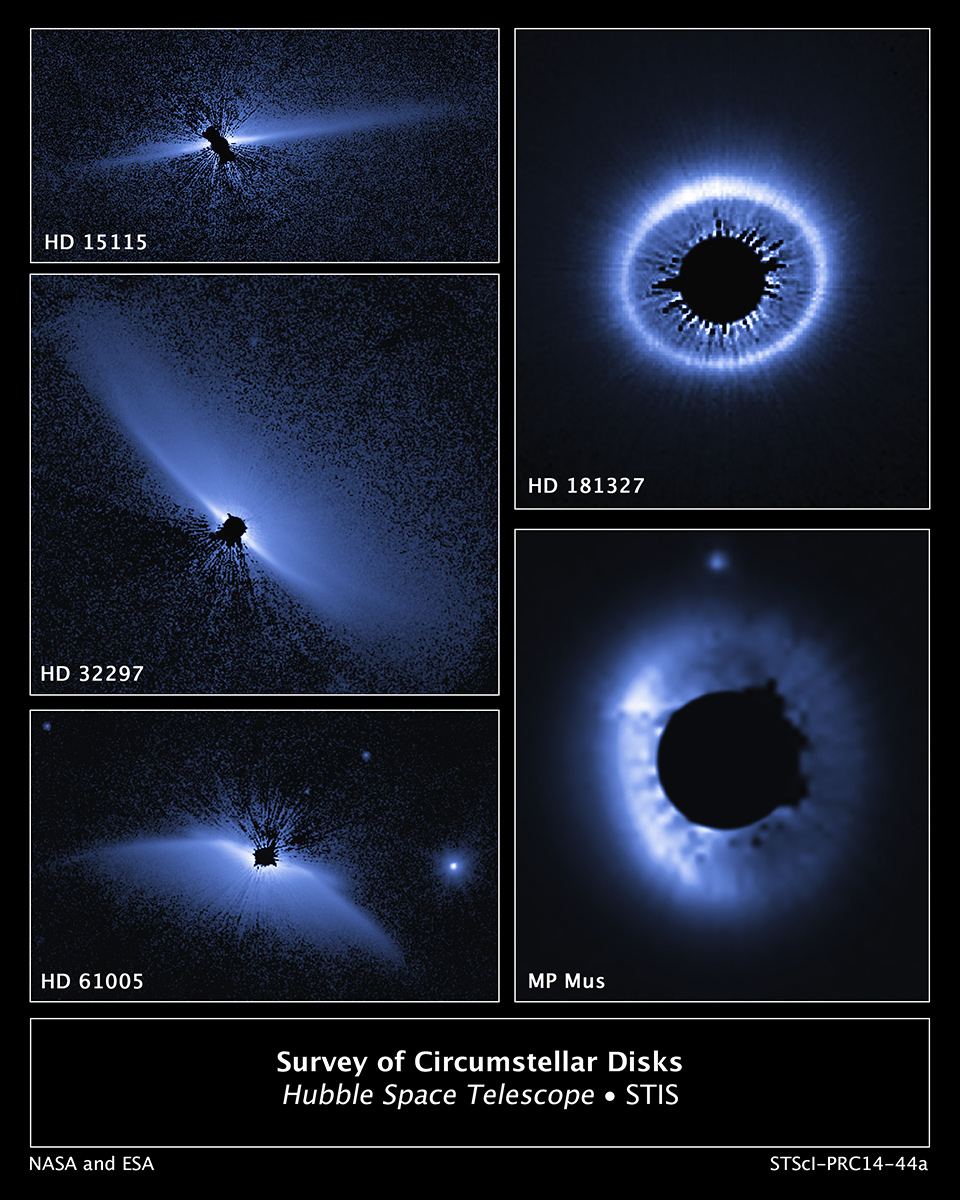
Ultrasound imaging technology has allowed medical doctors to directly observe a baby inside its mother’s womb in an efficient manner and study its natural development throughout the course of pregnancy, while providing parents with images of life’s wondrous formation process at the same time. On a larger cosmic scale, similar life-bearing, awe-inspiring processes occur as well, inside the large circumstellar disks of dust and gas that surround the very young and newly formed stars in the Universe, providing the raw material out of which planets (and potentially life) eventually evolve. The observation of these faraway cosmic structures (as well as everything else that we can see in the night sky) is conducted not through the utilisation of sound waves, but through the study of the light that the former emit in multiple wavelengths. Now, as part of an observing campaign which utilized the superior capabilities of the Hubble Space Telescope, astronomers have managed for the first time to image the inner regions of circumstellar dust debris disks around 11 nearby young stars in visible light in unprecedented detail, revealing their previously unseen complex and chaotic structures, while allowing astronomers to gain important insights into the late stages of planetary formation.

As evidenced by the more than 1,800 confirmed exoplanets and 4,000 exoplanet candidates that have been discovered to date, planetary formation is a natural byproduct of the formation of stars. According to the currently accepted model, planets are the end result of the accretion of gas and the coalescence of microscopic dust grains inside the protoplanetary disks of material that surround newly formed stars during the first few million years of their lives. In this scenario, the circumstellar disk’s volatile compounds—like water, ammonia, methane, hydrogen, and nitrogen—are concentrated far from the star where temperatures are low enough for them to condense into icy dust grains, forming tiny planetesimals out of which gas giant planets will later emerge through gas accretion processes. In the inner part of the disk, however, where temperatures are much higher, all of the gaseous material will either boil off due to the star’s intense heat or fall onto the star itself, leaving behind only microscopic solid particles of rock and metal that will later clump together to form small terrestrial planets.
These planetary formation processes are believed to take place during the star’s first 10 million light-years, after which most of the disk’s remaining primordial material is either cleared away by the star’s radiation pressure or coalesces to form large, dozens-of-Astronomical-Units-wide, debris disk of minor bodies like comets and asteroids that surround the young star, similar to the Asteroid and Kuiper Belts of our own Solar System. As the planetary system evolves, gravitational interactions with nearby major planets and other minor bodies lead to frequent collisions within these disks, continuously replenishing them with fresh second-generation material of dust particles.
Such dust debris disks around other stars were first discovered during the early 1980s with the Infrared Astronomical Satellite, or IRAS, which conducted the first-ever all-sky survey in infrared wavelengths above the Earth’s atmosphere. During its mission, IRAS detected an excess of infrared radiation coming from the bright nearby stars Vega, Beta Pictoris, Epsilon Eridani, and Fomalhaut, indicating that the latter were surrounded by vast disks of dusty material which extended out to hundreds of Astronomical Units away from their host stars. Since then, astronomers have been able to discover a total of 24 such circumstellar disks around other stars, utilising a multitude of next-generation ground- and space-based observatories, like NASA’s Spitzer and the European Space Agency’s Herschel space telescopes, as well as with the European Southern Observatory’s Very Large Telescope and more recently the Atacama Large Millimeter/submillimeter Array, or ALMA, in Chile. Yet, despite the greater capabilities of these observatories compared to IRAS, the detailed study of these circumstellar environments had been plagued by optical artifacts and an overall lack of sufficient resolution, which prevented astronomers from directly observing the inner regions of the disks and spatially resolving their dust structures. This overarching goal was finally achieved during an observing campaign that was undertaken by the joint NASA/ESA Hubble Space Telescope, which imaged the circumstellar debris disks around 11 nearby stars that lie at distances between 32 and 365 light-years away and are between 10 million and 1 billion years old. As part of the campaign called HST/GO 12228, whose results are detailed in a study that was published in the Oct. 1 issue of The Astronomical Journal, a team of international astronomers utilised the coronagraph on Hubble’s Space Telescope Imaging Spectrograph, or STIS, for a total of 88 orbits between May 2011 and November 2012, in order to block the overwhelming glare of the survey’s host stars and image the faint light that was scattering off the inner regions of the nearby circumstellar dust material.
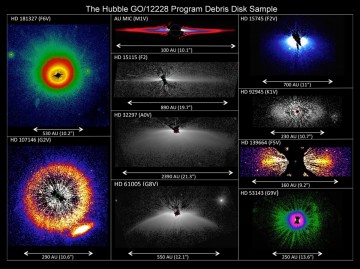
Even though the survey’s host stars had been previously observed again with Hubble using the space telescope’s now-defunct NICMOS and ACS coronagraphs, the HST/GO 12228 research team nevertheless achieved an unprecedented spatial resolution and sensitivity with Hubble’s similar STIS instrument, allowing them to observe the fine details and complex structures of the circumstellar debris disks and resolve the dust distributions for half of them, at distances below 5 Astronomical Units from their host star—a distance comparable to that of Jupiter from the Sun. This enchanced resolution allowed scientists to probe into the debris disks deeper than any other previous similar survey had ever achieved. “Our STIS images directly reveal disk features and substructures unseen in precursor Hubble discovery data, and components that had been inferred from spectral energy distribution modeling, but not previously observed directly,” write the researchers. “These visible-light observations provide imagery with spatial resolution comparable to that which ALMA should soon provide, and an order of magnitude better than delivered by the Herschel Space Observatory.”
One of the study’s important findings has been that not two debris disks look alike, displaying complex morphologies and significant asymmetries in their dust structures. “We find that the systems are not simply flat with uniform surfaces,” says Dr. Glenn Schneider, a professor of astronomy at the University of Arizona and lead author of the study. “These are actually pretty complicated three-dimensional debris systems, often with embedded smaller structures. Some of the substructures could be signposts of unseen planets.” The disk around one of the surveyed stars for instance, named HD 181327, exhibits a narrow debris ring which ejects large amounts of dust material toward the disk’s outer regions at distances greater than 80 Astronomical Units away, while surrounded by a much larger, asymmetric halo of light-scattering dust particles. Could this be due to a collision between large, unseen planetary bodies inside the disk? “In the case of HD 181327, the differences now observable in scattering phase functions in the ring and in the outer halo further suggest the presence of an unseen, planetary-mass perturber that may lie exterior to the ring,” comment the researchers in their study. “Additionally, these improved data have resulted in the putative discovery of a debris ‘spiral,’ or spray of ejecta, from a posited recent massive collision in the exo-Kuiper Belt [areas] of the HD 181327 debris system …With these data, we are now at the point of directly imaging phenomena postulated as important in the evolution of our Solar System, bringing the analysis of exoplanetary systems with HST into a new regime.”
“This spray of material is fairly distant from its host star — roughly twice the distance that Pluto is from the Sun,” adds Christopher Stark a Postdoctoral Research Fellow at NASA’s Goddard Space Flight Center in Greenbelt, Md., and co-author of the study. “Catastrophically destroying an object that massive at such a large distance is difficult to explain, and it should be very rare. If we are in fact seeing the recent aftermath of a massive collision, the unseen planetary system may be quite chaotic.”
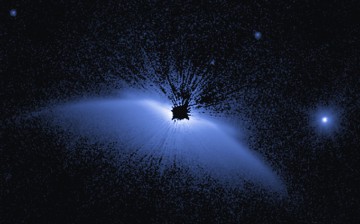
Another target of the HST/GO 12228 survey was HD 61005, a 40-million-year-old, solar-analog star located approximately 88 light-years away, whose circumstellar environment exhibits a highly asymmetric edge-on debris disk, nicknamed “The Moth” due to its highly unusual shape which resembles a flying insect. Previous Hubble observations had indicated that HD 61005 is probably plowing through a dense region of the interstellar medium, forming a “bow shock” in the direction of motion and causing some of the disk’s material to be swept behind the star. The new Hubble observations reveal the disk’s inner regions in an enhanced detail, allowing astronomers to confirm previous hypotheses about the physical processes inside the disk. “The [Hubble] image of the HD 61005 debris system reveals with clarity a highly inclined debris ring and its (dark) central clearing to a stellocentric [distance] of approximately 10 Astronomical Units, [showing] the debris ring itself, and the inner part of the skirt of material ‘blowing’ off the ring and of its front-edge bow, enhanced in visibility at the extreme from the dust opacity along the line of sight,” writes Schneider’s team. “This ‘skirt’ of (likely small) particles emanating from the previously unresolved inner part of this complex debris structure is likely pushed back from the disk plane as the system plows through the interstellar medium.”
Besides providing valuable and important insights into the physical processes that govern circumstellar dust disks, Hubble’s newest findings add an important dimension in exoplanetary research and planetary evolution studies as well, allowing researchers to better understand the differences between the dust disks where planetary formation has taken place and those that have been shaped in the absence of any major planetary bodies. “These images highlight the fact that debris disks are highly dynamic and complex environments,” concludes the study. “The picture that emerges, even from this small sample of previously imaged debris disks, is one of system-to-system diversity, perhaps matching the diversity of exoplanets and exoplanetary systems known from radial velocity and transit studies.” Yet the most important aspect of these new Hubble images might be their importance to the comparative studies of the development and evolution of our own planetary family in relation to the rest of the galaxy. “It’s like looking back in time to see the kinds of destructive events that once routinely happened in our Solar System after the planets formed,” says Schneider.
Indeed, as the history of astronomical study has repeatedly shown, learning more about the Universe is to learn more about ourselves.
Below are more Hubble images from the HST/GO 12228 observing campaign:
(Credit for all images: NASA, ESA, G. Schneider (University of Arizona), and the HST/GO 12228 Team)
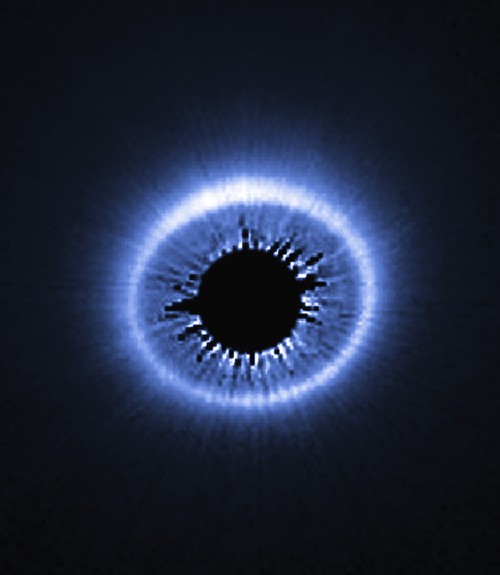
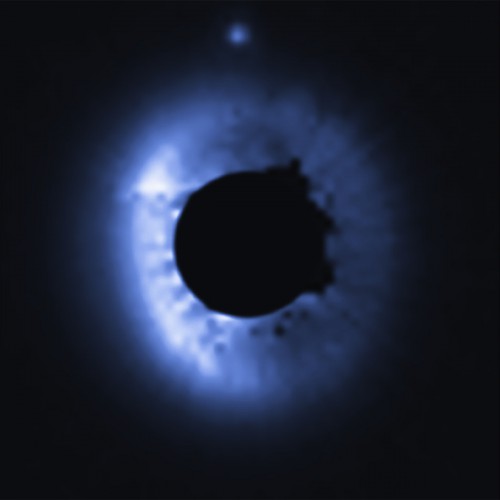
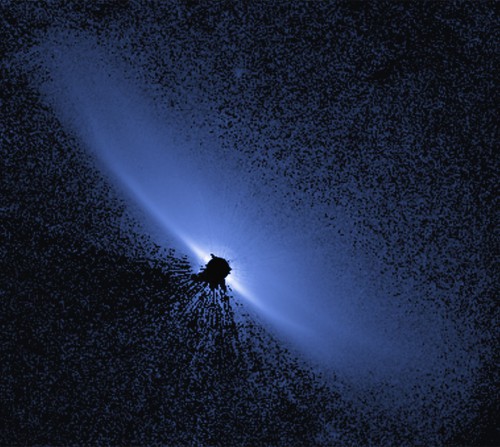
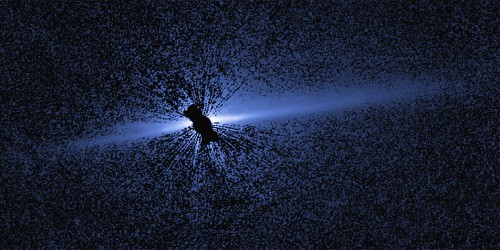
Want to keep up-to-date with all things space? Be sure to “Like” AmericaSpace on Facebook and follow us on Twitter: @AmericaSpace




Another wonderful article, Leonidas. Your concluding statement is both beautiful and profound in its simplicity.
Thank you Tom!
Leonidas,
This is a faciniating article and I want to be sure of what I am seeing .. Is the inner black circular item the actual planet forming to become either a gas planet or a rocky planet? Or is that the star that is sending material out from it that will become the planet.?
Tracy, those black circles in the center of the pictures coincide with the location of the host stars around which the circumstellar dust debris disks are developing. The stars’ intense light is being blocked (like an artificial solar eclispse of shorts) by the STIS coronagraph on Hubble, so that the much fainter light of the disks can become visible.
The circumstellar disks that Hubble has observed are between 10 million and 1 billion years old, which means that they all are at the very late stages of planetary formation. They are composed of second-generation dust material (originating from the continuous catastrophic collisions inside large asteroid and cometary belts that surround the stars). Astronomers couldn’t previously discern whether this material was destroyed through gravitational interactions with massive nearby planets or not. Hubble’s detailed observations have revealed their complex and assymetric structures, which strongly indicate that they are probably preturbed by unseen massive objects, meaning that planetary formation has indeed already taken place. As for HD 181327, the most probable explanation for the ring of material that is shot away from the star, is that it’s caused by collisions between dusty planetesimals and an object at least as big as Pluto.
“within the star’s first 10 million light-years”?
Thanks for pointing out that grammatical error Alfredo, article updated accordingly…